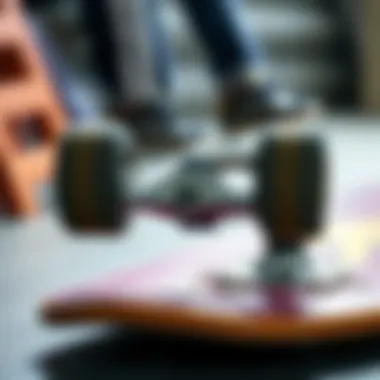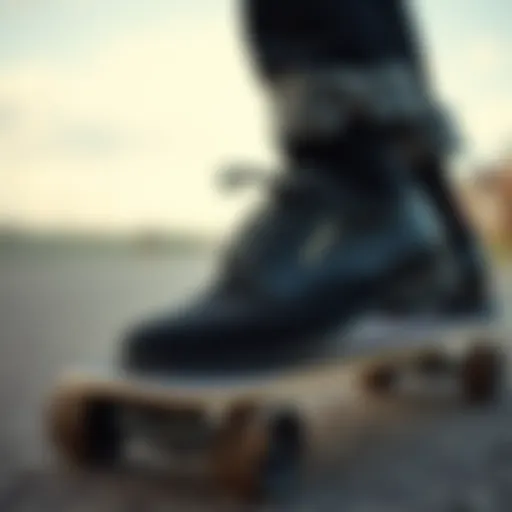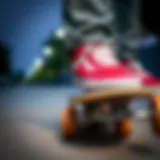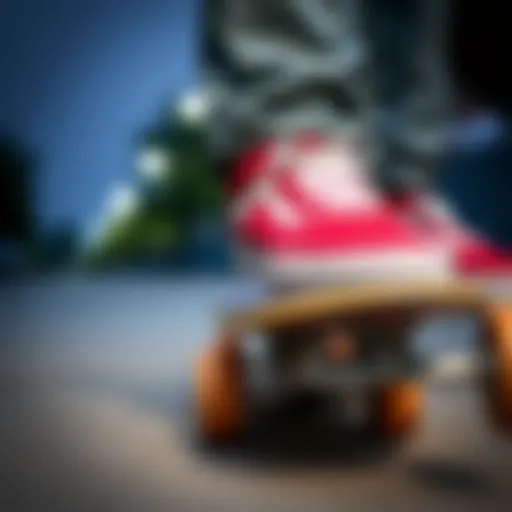Understanding Skate Trucks for Better Performance


Intro
When it comes to skateboarding, the choice of gear can make or break your entire experience. One might think the focus is solely on the board itself, but it’s the skate trucks that hold the real magic. Skate trucks, those metallic components that allow for turns, stability, and overall performance, are often overlooked by novices. Understanding how these parts function and how they interact with your skateboard setup is vital for achieving better performance and comfort.
In this article, we’re diving deep into the world of skate trucks. We’ll outline their roles, inspect different types, and detail how to match them to your personal skating style. Whether you’re just starting or you’ve been around the block a few times, learning about these components can lead to smarter choices, improved tricks, and a more enjoyable ride. So, let’s roll up our sleeves and get started!
Tricks and Techniques
Step-by-step Guides to Popular Tricks
To fully appreciate your skate trucks, mastering a few core tricks is key. Here, I'll walk you through some popular moves, highlighting how your truck choice can influence their execution.
- Ollie
- Kickflip
- Start with your feet in the proper position: back foot on the tail, front foot near the middle.
- Crouch down and prepare for the pop.
- Push down hard with your back foot to snap the tail down.
- As the board rises, slide your front foot up to level it out in the air.
- Land with both feet on the bolts for stability.
- Begin in the same position as the Ollie.
- When you pop the tail, use your toes to flick the edge of the board sideways.
- As it flips, keep your eyes on the board.
- Land softly to absorb the impact, ensuring your weight is centered over the trucks.
Remember, the width and responsiveness of your trucks can dictate how well the board reacts in the air. Trucks that are too wide or too narrow may complicate these tricks.
Common Mistakes and How to Avoid Them
When pursuing these tricks, beginners often stumble into a few pitfalls:
- Over-Compensating with Your Weight: Shifting too much weight toward your back foot can lead to unsteady landings. Try to center your weight over the board for balance.
- Incorrect Foot Placement: Positioning your feet too far forward or back can hinder Ollies and flips. Use guides or markers to establish a good stance on your board.
- Ignoring Your Trucks: Choosing the wrong size or hardness of trucks can make tricks harder to land. Understanding your setup is crucial.
"The right setup is half the battle in skateboarding, especially when it comes to mastering tricks."
Gear and Equipment
Reviews and Comparisons of Skateboards and Accessories
When it comes to trucks, not every piece of equipment is created equal. It's essential to know what’s out there.
- Independent Trucks: Renowned for their reliability and response, these trucks are favored by many professionals. They offer a solid mix of durability and turn rate, making them versatile for most tricks.
- Tensor Trucks: Lightweight and designed for technical tricks, these trucks excel on ledges and rails. However, they may lack the stability for larger ramps.
- Thunder Trucks: Known for their speed and stability, Thunder trucks are a go-to for street skaters. Their unique pivot point enhances turn capabilities without compromising strength.
Essential Gear for Beginners and Advanced Skateboarders
Whether you’re new to skating or have been grinding for years, equipping yourself with the right gear is crucial. For beginners, a good pair of trucks like the Independent Stage 11 or Venture Trucks can support your early learning curve.
Advanced skaters may want to consider adjustable truck setups that allow customization in responsiveness and height. This can play a significant role in how tricks are executed and overall ride comfort.
Foreword to Skate Trucks
Skate trucks are the unsung heroes of any skateboard setup. While wheels and decks often grab the limelight, it's the truck that serves as the crucial link between rider and board, influencing how one skates and performs tricks. Understanding skate trucks is essential, as they dictate stability, turning capabilities, and overall ride feel. A good set of trucks can mean the difference between an exhilarating performance and a ride marred by instability or poor turning response.
The relationship between a truck's design and the skater's experience is intricate. Several factors play a role in determining which truck will suit a rider best, such as riding style, skill level, and personal preferences. More than just a manufacturing detail, selecting the ideal truck is pivotal for maximizing not only trick execution and comfort but also safety on the board.
Definition and Purpose
In simple terms, a skate truck is a metal frame positioned underneath the deck of a skateboard, composed mainly of several moving parts that allow for rotation and adjustment. Designed primarily for two main purposes: support and maneuverability, trucks help maintain balance while allowing riders to carve or turn with ease.
The truck acts as the fulcrum of the skateboard. Its baseplate attaches securely to the board, while the hanger allows for the wheels to spin freely around the axle. This design grants skaters responsive control, offering the ability to execute tight turns, stabilize during grinds, or simply cruise comfortably down the street. Ultimately, trucks enable a skater to translate their physical movements into seamless actions on the skateboard.
Historical Development
The origins of skate trucks trace back to the early days of skateboarding in the late 1940s and early 1950s. Skateboarding emerged as a play activity for surfers looking to emulate waves on solid ground. Early trucks were largely adapted from existing roller skate technology, featuring simple designs that lacked the sophisticated engineering we see today.
Over the decades, the evolution of skate trucks kicked into high gear. By the 1970s, skateboarders began experimenting with different styles and materials, prompting manufacturers to create trucks that were lightweight yet sturdy enough to handle powerful jumps and tricks. Innovations in materials like aluminum, along with design improvements such as the introduction of wider baseplates and better kingpin angles, significantly advanced performance.
As skateboarding gained popularity throughout the decades, so did the customization of equipment. Companies began focusing on tailoring trucks to cater to distinct riding styles, reflecting the growing diversity in the skateboarding community. Today, skateboarders are presented with a multitude of options, catering to everything from street skating to vert ramps, showcasing just how pivotal trucks are in a skater's arsenal.
As the landscape of skateboarding continues to evolve, so do the discussions around trucks. The intersection of design, material science, and rider feedback is shaping the next generation of skate trucks, ensuring that they remain an integral part of skate culture. It's evident that understanding skate trucks taps into a crucial element of the skateboarding experience.
Anatomy of a Skate Truck
The anatomy of a skate truck is fundamental to understanding its role in the overall function of a skateboard. Each component plays its part in the truck's performance, influencing stability, turning capabilities, and the rider's experience on the board. A well-balanced skate truck is crucial for optimal maneuverability, and knowing the specifics of its components can help skateboarders make informed choices.
Baseplate


The baseplate is the heart of the truck, attaching it securely to the skateboard deck. This component often sets the stage for the truck's height and stability. A solid baseplate ensures that the rider has a reliable point of contact, leading to better control and balance while skating. Some skaters prefer a baseplate with additional holes for mounting, allowing for more flexibility in their setup.
Furthermore, the materials used can range from aluminum to more advanced composites. Stronger materials can withstand more force, thus enhancing durability. Ultimately, the baseplate is vital for maintaining the skateboard's integrity during tricks and everyday riding.
Hanger
The hanger is a component that connects the axle to the baseplate. It's this part that allows for the pivotal movement when turning. The width of the hanger significantly affects how a board feels on the turns. Wider hangers often provide better stability at high speeds, which is crucial for downhill or skate park riding.
On the other hand, narrow hangers can enhance maneuverability and are typically favored by street skaters looking to perform technical tricks. Knowing what type of riding you’ll be doing can dictate the preferred hanger width. Moreover, innovative designs may incorporate features that further enhance turning ability while also promoting lightweight construction.
Axle
The axle is the rod that extends out from the hanger, allowing the wheels to spin freely. Choosing the right axle length is essential for ensuring compatibility with different wheel widths. A poorly fitted axle can cause unwarranted wear on the wheels and adversely affect skating performance.
Furthermore, certain axles offer features such as easy access for wheel changes and maintenance. Understanding the relationship between axle length and wheel size can save skaters from a slew of frustrating experiences during rides. In this regard, the axle serves not only functional purposes but also dictates overall riding efficiency.
Kingpin
Think of the kingpin as the pivotal point of the entire truck system. It's the bolt that holds the hanger to the baseplate, enabling the truck to tilt side to side when turning. The design of the kingpin can vary, with some being designed for low-profile trucks, while others cater to high trucks, affecting both height and turning characteristics.
A well-constructed kingpin allows for smooth turns and can endure high levels of stress during tricks. Skaters are often advised to check their kingpin regularly, as it’s a common point of failure, especially for those who engage in aggressive riding styles.
Bushings
Bushings are the rubber components that fit around the kingpin and allow the truck to pivot. They absorb impact and give skaters the necessary cushioning during tricks, which can drastically alter a rider's feel on the board. Different hardness levels of bushings can instigate varying responsiveness; hard bushings can lead to tight turns and a stiff feel, while soft bushings may contribute to loose turns and a more forgiving ride.
Ultimately, the performance of bushings can make or break a skater's experience, allowing for custom setups that fit individual preferences. Varying the bushings according to one's skill level and style can also have a substantial impact on overall riding dynamics.
Understanding the anatomy of a skate truck isn’t just for the mechanics; it’s a pathway to enhancing your skateboarding experience.
By knowing each of these components and how they interact with one another, skateboarders can make the best choices for their individualized setups, enabling them to improve their skills or simply enjoy a smoother ride.
Types of Skate Trucks
Understanding the different types of skate trucks is pivotal for both new skaters and seasoned pros alike. The type of truck selected can significantly impact not just how a board performs, but also how a rider feels when pushing their limits. Each category presents unique benefits, considerations, and applications suited to different riding styles and preferences.
Standard Trucks
Standard trucks are the bread and butter of skateboarding, favored for their versatility and compatibility. Riders can expect them to perform well across a variety of terrains – be it street skating or bowl riding. Generally speaking, standard trucks bring about a good middle ground in terms of height and width, which makes them a reliable option for many.
- Advantages:
- Considerations:
- Easy to find in most skate shops
- Suitable for a range of skateboarding styles
- Generally more affordable than specialty options
- May not offer the precision needed for more advanced tricks
- Might limit some maneuvers compared to specialized trucks
High Trucks
High trucks are not just a height advantage; they're specifically designed for those who are looking to pull off expansive tricks. Elevating the board allows for better clearance while performing ollies or other aerial maneuvers. With a higher center of gravity, these trucks offer a different kind of stability which can translate well during vertical jumps.
- Benefits:
- Potential Downsides:
- Enhanced pop for tricks requiring height
- Great for riding transitions like ramps and halfpipes
- Might be less stable for street skating
- May feel tippy for some riders
Low Trucks
Low trucks provide a close-to-the-ground feel that many skateboarders favor for technical street tricks or flip tricks. The lower profile offers a more stable base for confined environments, thus helping skaters lock in their tricks with more precision. When riding ramps, however, caution is necessary to avoid wheel bite.
- Pros:
- Cons:
- Excellent for technical tricks requiring stability
- Can create smoother turns due to lower center of gravity
- Higher risk of wheel bite during aggressive turns
- Limited compatibility with wider decks
Mid Trucks
Mid trucks take the best of both worlds, offering a balance between height and performance. Offering an elevated feel without compromising stability, they cater well to skaters who need versatility but also enjoy some air beneath their feet. Mid trucks often perform commendably on both street and park environments, making them an ideal choice for riders who switch frequently between different styles.
- Highlights:
- Drawbacks:


- Works well for a mixed repertoire of tricks
- Provides a happy medium for most riders
- Might not excel as much in any one category compared to specialized trucks
- Requires careful matching with board width
Specialty Trucks
These are niche options designed for specific purposes. From longboard trucks to cruiser setups, specialty trucks let skateboarders express unique riding styles or cater to their unique needs. If you’re a downhill rider, a soft pivoting truck might be your best friend, while board slide specialists may turn to something with wider baseplates for stability.
- Examples Include:
- Considerable Facts:
- Longboard trucks for cruising and downhill stability
- Slalom trucks for precise cornering
- Split trucks for tricks requiring more flex
- Specialized trucks can enhance a specific style but may limit versatility
- Often more expensive than standard options
Understanding the different types of skate trucks is essential for optimizing your riding experience. Different skaters have different needs, and the right truck choice can markedly influence performance.
Each type of truck has its purpose and fits particular skating styles or personal preferences. The next step is figuring out how to choose the right truck for your needs.
Selecting the Right Skate Truck
When it comes to skating, picking the right skate truck can make all the difference between a smooth ride and a bumpy one. The choice of trucks isn’t just about aesthetics; it’s a pivotal factor that affects your skating performance, control, and comfort. Knowing how to match your trucks to your style and needs is crucial, especially if you want to skate like you mean it. Here, we’ll dive into some key considerations.
Rider Weight Considerations
Your weight can significantly impact how skate trucks perform under your feet. Different trucks are designed to handle various load weights. If you’re a heavier rider, larger trucks that are more robust might suit you best, as they provide stability and support. Conversely, lighter riders can benefit from more agile, lower trucks that allow for quicker movements and easier tricks.
In addition, the bushings used in the truck impact responsiveness. Heavier riders might prefer harder bushings for enhanced support, while lighter riders can opt for softer bushings that give a more forgiving feel. Ultimately, matching the truck to your weight helps in achieving a harmonious balance between performance and comfort.
Board Width Compatibility
It’s like trying to fit a square peg in a round hole—using truck widths that don’t match your board width can lead to handling issues. The wider the board, the wider the trucks should be. If you have a board that's 8.5 inches wide, for instance, you would ideally go for trucks that measure around 8 to 8.5 inches in width.
The proper width helps maintain stability during tricks and turns. If the trucks are too narrow, you’re more likely to encounter wheel bite, where your wheels catch against your board during turns. If they’re too wide, it might throw off your balance. Checking the compatibility of your trucks and board can save you from a bad skating experience.
Riding Style Influence
Your riding style plays a pivotal role when selecting the right trucks. Each style of skating demands different characteristics from the truck.
Street
Street skating demands a lot of technical tricks, which often require trucks that are both responsive and stable. The key characteristic of street trucks is their maneuverability, allowing skaters to quickly pivot and perform tricks like grinds and ollies.
The unique feature of these trucks is their lower height, aiding in flip tricks. However, they might be less stable at higher speeds. Skateboards often use mid-range infant trucks for street skating, allowing skaters to find a balance between agility and stability.
Park
When hitting the park, you want trucks that feel solid and supportive. Park skating is all about using ramps and transitions, which means having reliable turning capability is crucial. The key characteristic here is stability, as tricks often require speed and confidence.
Skaters might prefer trucks with a bit more height to enable better grind clearance. The advantage of park trucks is their stability at high speeds, although they can be a bit slower to maneuver compared to street trucks.
Vert
For vertical skating, the stakes are high, and performance is key. Trucks used for vert are usually taller, providing a wider turning radius and supporting stable landings from big airs and transitions. The unique feature of vert trucks is their ability to keep skaters steady during high-speed runs on vert ramps.
This kind of stability comes with the disadvantage of being less suited for tight street skating, but they excel on larger setups.
Freestyle
Freestyle skating is a different beast altogether, favoring creativity and variety in tricks. Trucks designed for freestyle typically emphasize lightness and maneuverability over stability. The key characteristic is their responsiveness to quick movements, vital for intricate tricks.
The advantage of lightweight freestyle trucks is their ability to assist in flip and slide tricks, giving skaters the edge to express their creativity. But a downside might be that they'll lack the rigidity required for high speeds or larger drops.
No matter what style you gravitate toward, understanding how your choice affects performance is paramount. Carefully considering these factors will guide you in selecting the right skate trucks for your ride.
Maintenance and Performance of Skate Trucks
Maintaining skate trucks is crucial for ensuring optimal performance on the board. Just like any mechanical device, if you want it to last and perform well, you must keep it in good shape. Regular maintenance can enhance the responsiveness of your board, increase stability during tricks, and prolong the life span of the trucks themselves. Neglecting the maintenance can lead to unwanted noise, reduced performance, and faster wear and tear.
Lubrication Techniques
Lubrication is a key aspect of maintaining your skate trucks. It prevents metal parts from grinding against each other, which can lead to deterioration. Here’s how you can keep your trucks well-lubricated:


- Use the Right Lubricant: Avoid heavy grease, as it can attract dirt. Instead, opt for a lightweight oil designed for skate applications. Options like 3-in-1 oil or silicone-based lubricants are great choices.
- Regular Application: Make it a habit to check the bushings and axles regularly. A few drops of lubricant every couple of weeks can greatly enhance the performance.
- Cleaning Before Lubrication: Always clean the joints and bushings before applying new lubricant. This helps to remove any dirt and debris that could hamper the effectiveness of the lubricant.
You might also consider taking apart the trucks every now and then for a deeper clean. Make sure to do this carefully, noting how each piece fits together for reassembly later.
Checking Alignment
Alignment is another paramount aspect that influences the performance of your skateboard. Misalignment can result in uneven wear, difficulty in turning, and loss of stability. Here's what you should consider:
- Visual Inspection: Regularly check that the hanger and baseplate are aligned properly. A simple look will let you know if something seems off.
- Wheel Alignment: Ensure the wheels spin freely and do not rub against the truck. If they do, it could indicate a misalignment that needs addressing.
- Test Ride: The best way to check alignment is to go for a short ride. Does the board feel like it turns easily, or is it pulling to one side? If it's pulling, it’s time to correct the alignment.
When to Replace Trucks
Knowing when to replace your skate trucks is just as important as maintaining them. Here are some signs that suggest it might be time for an upgrade:
- Excessive Wear: Inspect for deformities like warping or cracks in the metal. If any part seems compromised, don’t hesitate to replace the truck.
- Instability: If your board starts feeling wobbly or less stable than before, it may signal that the components of the truck have been worn down.
- Duration of Use: If you frequently skate and have been using the same pair for over a few years, they might need replacing regardless of how they look.
It’s recommended to replace trucks as soon as you notice any indicators that suggest future problems. Continuously riding on degraded trucks not only impacts your performance but can also lead to injury.
A well-maintained truck not only improves your riding experience but ensures longevity for your entire setup.
Maintaining your skate trucks is not just about performance; it’s an integral part of skateboarding culture. A regular maintenance routine paired with vigilant inspections can enhance your overall riding experience and keep you going strong for years to come. Following these guidelines can lead you to enjoy a smoother ride and better tricks on your board.
Impact of Skate Trucks on Tricks and Riding Feel
Understanding how skate trucks influence tricks and the overall riding experience is crucial for anyone looking to master the art of skateboarding. The interplay between truck design and riding style can significantly shape performance, either by enhancing or hindering a rider’s ability to execute tricks. Here, we'll delve into the distinct factors that come into play, shedding light on how these components affect stability, turning radius, and the execution of ollies and grabs.
Influence on Stability
The stability of a skateboard is not just about the board or wheels; it heavily depends on the trucks as well. When it comes to doing tricks or cruising, a stable setup helps a skater feel secure on their board. Trucks with a wider base and a lower profile often provide better stability.
- Wider Trucks: Broader trucks distribute weight more evenly, helping prevent wobbling, especially at high speeds or during tricks.
- Low Trucks vs. High Trucks: Usually, low trucks are favored for street skating since they lower the center of gravity, enhancing balance during technical tricks. High trucks, on the other hand, typically offer more clearance for grinds but can sometimes feel less stable on landings.
In essence, the stability from well-chosen trucks can mean the difference between landing or eating pavement during a slide or flip trick.
Effect on Turning Radius
Turning radius is another fundamental aspect in which skate trucks prove vital. Depending on their width and design, trucks can drastically alter how sharply a skateboard can turn.
- Loose vs. Tight Bushings: Trucks that have looser bushings tend to allow for sharper turns but can make the board feel unstable if pushed too far. Conversely, tighter bushings may provide a more controlled turn but can restrict maneuverability for tricks that involve a lot of carving.
- Kingpin Angle: The angle of the kingpin also plays a role in how trucks behave while turning. A more upright kingpin can lead to quicker turn initiation, whereas a reclined kingpin might offer smoother turns.
For skaters weaving through busy streets or executing quick tricks on ramps, the right turning radius can make riding feel fluid and less awkward.
Contribution to Ollies and Grabs
The ability to perform ollies and grabs hinges, in part, on the right truck setup. Trucks have a direct impact on how the board reacts during these types of tricks.
- Truck Height: When attempting ollies, the height of the truck affects the overall leverage a skater has. Taller trucks allow for bigger ollies due to the higher lift off the ground, but they may come at the cost of stability. Conversely, shorter trucks can aid in control but may limit the height achievable during an ollie.
- Bushings and Flexibility: The responsiveness of the bushings also contributes. Softer bushings allow for a quicker response during trick execution, which is beneficial for tighter grabs and variations. Stiffer bushings provide more resistance but can enable stronger landings after big air.
Thus, choosing skate trucks that cater to one’s trick style can elevate performance in more ways than one, ultimately leading to a more enjoyable riding experience.
Key Takeaway: The right trucks can be a game-changer. They affect stability, turning abilities, and trick execution like ollies and grabs, allowing skateboarders to explore their full potential.
In summary, understanding the impact of skate trucks on tricks and riding feel is indispensable for riders at any level. A well-chosen truck setup not only enhances the stability and turning prowess but also contributes significantly to the technical execution of skills that skateboarders pride themselves on.
End
The conclusion of this exploration into skate trucks draws together the threads of knowledge shared, emphasizing the significance of informed choices within the skateboarding community. Not just mere hardware, skate trucks serve as critical points of connection between the rider and their board. Grasping their intricacies allows skaters to not only choose the right model that complements their riding style but also enhances their performance on different terrains.
Recapitulating Key Insights
Making an informed decision involves several key factors. Riders must take into account their weight, the width of their board, and their riding style. Standard trucks might work perfectly well for a casual skater, but someone with a penchant for street tricks may benefit from the agility of specialty trucks designed specifically for urban settings.
Here are the main points to keep in mind:
- Weight Factor: Heavier riders typically require stronger, more durable trucks, while lighter skaters can opt for lighter setups.
- Board Compatibility: Understanding the width of your skateboard is crucial. Trucks should complement the board's width for optimal performance.
- Riding Styles: Each style—be it street, park, vert, or freestyle—demands unique features from the trucks.
In reviewing these elements, one can appreciate how selecting the right truck influences overall skating experience, from maneuverability to stability and control. As such, thoughtful consideration can't be overstated.
Future Trends in Skate Truck Development
Looking ahead, the evolution of skate trucks appears to be driven by a blend of innovation and performance optimization. Manufacturers are constantly experimenting with materials and designs to create lighter, stronger, and more versatile options. For instance, the rise of composite materials can lead to a decrease in the overall weight of the trucks without sacrificing strength, catering to performance-driven skaters aims to push the envelope further.
Moreover, technological advancements might offer enhanced customizability. Envision trucks with adjustable features allowing skaters to fine-tune their setups in real time, enhancing responsiveness during rides.
Urban skateboarding is burgeoning worldwide, influencing designs to cater for enhanced durability against the harsher conditions of city environments. This trend points toward a shift in focus to urban resilience alongside performance.
Riders should keep an eye on these advancements, as they stand to redefine the conventional norms surrounding skateboarding gear. Consider connecting with platforms like Reddit or Facebook groups dedicated to skate culture for ongoing discussions and insights into these emerging trends.















